(Variations of the post title have been used elsewhere, I am aware)
Shark-a-bration Time!
Hello! Once again, it is once again shark week and I get to go off about my love of sharks.
I hope some of you got to see my post about spiritual lessons from sharks from a few days ago. If you did, good, if not, check it out.
Speaking of that post: I know that I came down pretty hard on shark misrepresentation in the media. Allow me to clarify my statements. Not literally all of Discovery or NatGeo’s shark content is complete nonsense or scientifically inaccurate. Some of it does involve legit scientists doing legit shark science. This clip, for instance:
It’s fifty shades of iffy but when I recognized Skomal and I saw what he was doing I let go of my reservations. Only in recent years has the Atlantic population of great whites been making a comeback. Skomal is on the front lines studying them.
What tipped me off was that (1) Greg Skomal is a real shark scientist, I’ve seen two of his TED talks, I know how he works, and (2) they’re tagging the shark to put a camera on it. I do watch clips from the shark specials, just as long as they’re in good taste and I learn something from them.
But here is the thing about mainstream shark specials:
- They are produced from the angle that sharks are monsters that people are in danger from
- Some of the “research” involves baiting or harassing the animals just to show off their strength or their teeth
- Some specials revolve around hunting down legendary monster sharks that could not possibly exist, and some of this to the point where the “science” is completely fabricated (*cough cough, Megalodon, cough*)
- Some of the shark scientists that are interviewed for these “documentaries” have their comments edited to reflect the filmmakers’ agenda
- It’s all about showing how “scary” sharks are and making them even scarier to people; it’s basically horror or thriller entertainment framed as a documentary.
Read More:
Commentary from a real Shark Biologist
Statistical Study of Sharks in News Reports
Even nature specials not focused on sharks but where sharks are mentioned will refer to them as monsters.
The thing with natural disasters, animal attacks included, is that they get the same treatment as disaster movies. Don’t take the hype hook line and sinker: if anything, watch it with a grain of salt.
You know what, maybe if I’m not actually watching “Shark Week” I shouldn’t call it such. How does Shark Splash sound instead? (But on the other hand, if I want an audience for my shark content…*le sigh*)
It’s the fault of Jaws, right? Right. Sharks as monsters is what sells. Here’s the thing about Jaws, though: like other “science fiction” films, it inspired people to become real scientists, including Greg Skomal, featured above. You can’t call that a negative impact.

Another funny thing about Jaws is that the shark wasn’t the real “villain” in the film: it was the mayor who insisted that it was safe to get back in the water in spite of the monster shark in the area, putting people’s lives at risk for political gain. Some people have been using this character as a metaphor for government leadership during the recent COVID-19 crisis.
Just a small personal update: I have acquired a couple more plush sharks in the last year.
Shark number one is Jingle Belle, but when it’s not Christmas I just call her Belle. I saw plush sharks similar to this one on a Facebook group and I had to have one! Turns out she is very soft. No regrets on that splurge.

Number two, well, he’s a little smaller. He’s a crochet shark that my mom made for me. I wanted him for Christmas/my birthday but my mom has to work a lot so she doesn’t have a lot of time for her craft projects. He ended up being finished around March-ish. He is small enough to smuggle into places where you normally wouldn’t find sharks and he’s a great little morale booster. Say hello to Fabio:

Fabio’s first Easter:
(Thank you mommy!)
Shark crochet pattern from Etsy
If you want to find information about shark conservation, there are plenty of people and organizations that can and will discuss it with you.

(If you would like some good sharky angst, check out my latest meme creation, Bohemian Sharksody)
Making people aware of the threats that sharks face is important. What about telling people about the things that make sharks wonderful and unique? If people only save what they love, then what is going to make people love sharks?

It seems like sharks are the exception to the rule of dangerous animals that people fall in love with and romanticize. Bears, for instance. Bears are known to be dangerous to humans. Teddy bears remain popular toys but we still know that real bears are wild animals that deserve respect.
Wolves, tigers, and other cute but dangerous animals are also popular. Wolves are loved for their spiritual and mystical associations and occasional squishiness. Tigers are loved for their power and grace. There are plenty of YouTube channels that show off their cute sides. Foxes and owls are popular as fashion statements. Why can’t sharks be appreciated for those qualities?
The thing with sharks is that they’re not quite as mainstream as other predators as print patterns on tote bags or other merchandise. They’re catching on, but they are still underrated to the point where they’re still unique. (Shark print patterns I think would be very chic, though)
I think sharks are absurd. The fact that people think they’re dangerous monsters but they’re actually pretty chill is half the charm. The other half? Well, their diversity is a huge factor. There’s also the fact that they have such morose facial expressions, from the grumpy frown of the whitetip reef shark
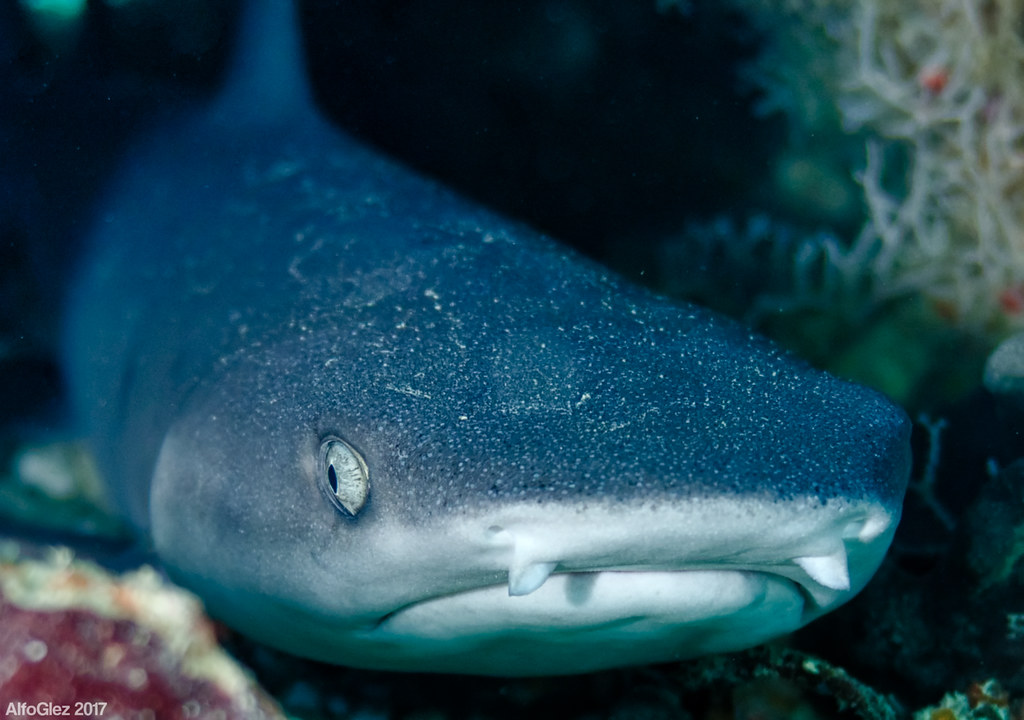
to the cautious glance of the normal reef shark
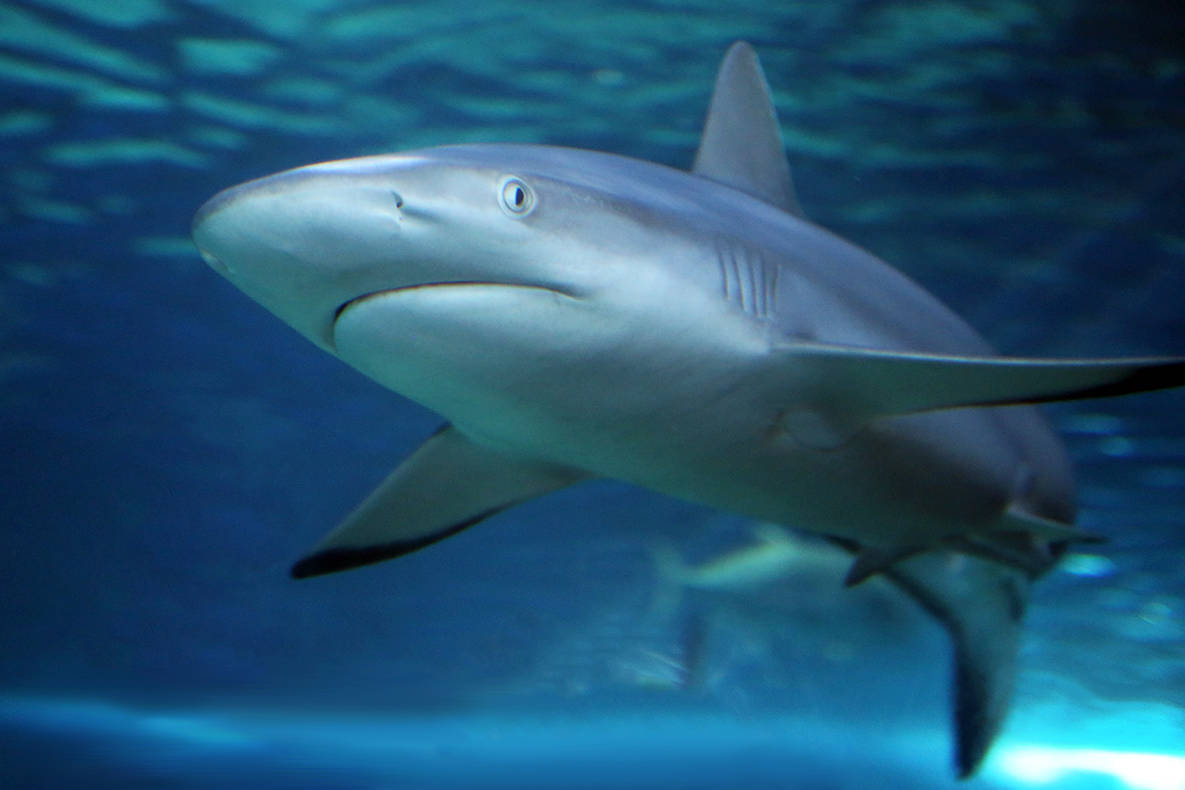
to the existential dread of the thresher shark that has made it a popular meme and a symbol of anxiety.
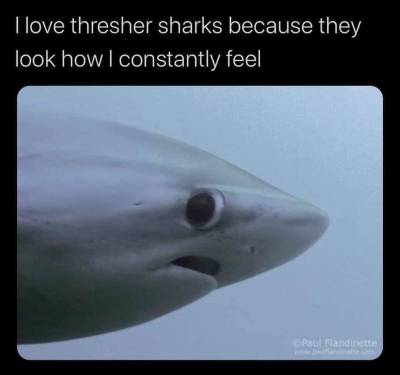
Individual sharks are known to have differing personalities, similar to cats, dogs, and even people. Science has proved this. Diver observation has confirmed it. Some are outright outgoing and others are very skittish. Some shark species are associated with certain temperaments–great hammerheads and threshers are known to be skittish, for instance, and Greg Skomal has described great whites as charismatic–but again, there are a range of attitudes, particularly when interacting with humans.
In that spirit, I am going to take a look at seven different shark species that I like. Some of them I didn’t get around to talking about in my post last year. Others are favorites that I have come to appreciate in the last year. A few of these indeed typify the “absurd” nature of sharks. Others defy the menacing predator stereotype altogether.
Blue Shark
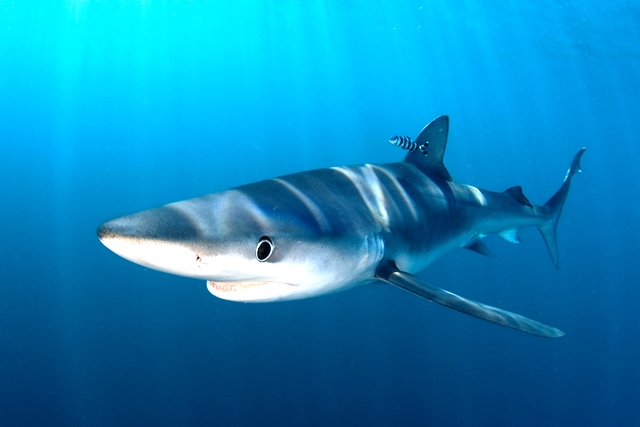
“I’m blue daba dee daba daba daba dee daba die daba dee daba die” Remember that song? Well, now it’s prionace glauca’s theme song. Maybe it always was.
Blue sharks look more like stereotypical sharks but with a few modifications. Their intense countershading is bright blue, like a blue sunburn. They also have very long, elegant, slender bodies, about 3-4 meters long (9-12 feet). IMO they’re simply gorgeous!
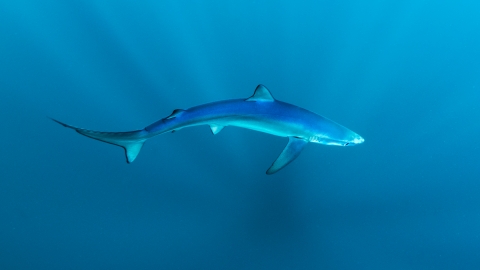
Blue sharks live in the open ocean and are found the world over, and they migrate across oceans on a regular basis to reach feeding and mating grounds. Common to pelagic (open-ocean) species blues have very very long pectoral fins that help them glide through the water. Their favorite food is squid.
These sharks have very large eyes for seeing in dark, deep water. They also have absurdly long noses proportionate to their face size. Take a photo of a blue shark at the wrong angle and…well…

Blue sharks are also known to live in schools or shivers of individuals of the same sex and similar age. While they are known to bite people occasionally, they are still a popular species for divers to hang out with.
A word to the wise: if you are hanging out with wild animals, don’t try to boop the snoot. But be aware that sometimes the snoot will boop you.
Video: Jonathan Bird Dives with Blue Sharks
Zebra Shark
This is the confusing one. The zebra shark often gets called a leopard shark because of its adult spots. It’s actually called a zebra shark because it is born with dark brown and white stripes. Even up through adulthood, however, adults will still have very faint zebra strikes. So we’ll stick with zebra.

The Zebra shark is the cinnamon roll of sharks. It lives in tropical reefs and sand flats of the Indian and eastern Pacific oceans. It grows to about 9ft (3m) long or bigger. The typical diet is invertebrates and small fish.
Some people think that the zebra shark looks friendly because of its facial structure: the mouth looks kind of like a grin.

The best feature of the zebra shark, however, is its tail, nearly the same length as its body, long like a ribbon and beautiful to watch in motion.

The zebra shark or stegostoma fasciatum is a bottom-dwelling species and breathes by buccal-pumping or in other words pumping water over its gills. Zebra sharks reproduce by laying eggs.

Here’s a fun fact: zebra sharks have a courtship ritual prior to mating. A male zebra shark will approach the female from behind and nibble on the very tip of her tail.

If the female is willing to mate, she will flip onto her back. If she isn’t interested or doesn’t want to procreate right away, the male will just hang on and be persistent. (Well, if he’s in an aquarium, he doesn’t have anything better to do.) Recently, however, a captive female made waves when she had pups asexually.
Zebra sharks are very friendly with humans and easily work with aquarium trainers in captivity. (Yes, belly rub boy is a zebra shark)
Video: Jonathan Bird dives with Zebra Sharks in Oman
(The Other) Leopard Shark
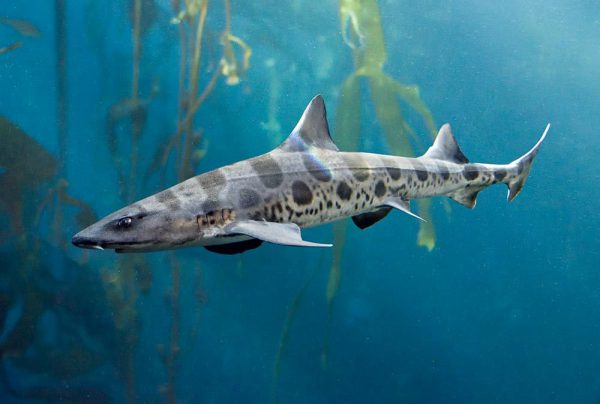
Triakis semifasciata is only found off the western coast of North America, from Oregon to Baja, which is why I propose calling it the California leopard shark. This shark grows to only four-feet (1 meter-ish) and dwells in the shallows, muddy bays, and temperate kelp forests, eating fish and invertebrates.
Leopard sharks are known to aggregate (gather) off the coast of California close to La Jolla in the summer, hanging out just beyond the surf zone.

Researchers have determined that this aggregation consists of mostly pregnant females who are “incubating” their unborn pups. (They are ovoviviparous, which means they keep their “eggs” inside of their bodies).
In contrast to the small spots of the Zebra sharks, Leopard sharks have large dark brown spots, many of which fold over their backs like saddles (which is why “saddleback sharks” would also be a viable alternative name).
Overall, leopard sharks are pretty animals and as far as shark species go they are underrated. Or maybe I’m just biased because of Leo.
Or, you know what, I’ll just tell you the truth: this is the closest opportunity for me to meet sharks in the wild from where I live (northern Arizona). (Okay, Rocky Point on the Sea of Cortez is physically closer, but it’s in Mexico, and, nothing personal against Mexico, but there are some complications with that trip.)
Video: The Research Report of the Scientist who Studied the La Jolla Aggregation, it’s about an hour long but if you like hearing about science research it’s a great video.
Bonnethead Sharks
Meeting any type of hammerhead shark is about as closest as you’ll get to encountering an alien, short of crossing paths with a cephalopod or actually leaving this planet.
There are about ten different species of hammerheads. My favorite one is the smallest, sphyrna tiburo, the bonnethead.
:max_bytes(150000):strip_icc():format(webp)/GettyImages-621261484-74c6c2734981457ba96b5b6200096bfc.jpg)
Bonnetheads live in tropical and subtropical waters of North and South America including on Gulf of Mexico and the coast of my native Texas. They get their name from the bonnet or shovel-shaped “hammer” or cephalofoil. They only grow up to about three feet in length, the biggest ones growing to five.

Similar to Leopard sharks, bonnetheads inhabit sand and mud flats in shallow waters. They do eat your typical small shark fare of small fish and crustaceans. HOWEVER, they have been scientifically proven in recent years to be omnivores. They graze on and digest seagrass. How cool is that?
Lemon Shark
Lemon sharks are the sunshine of my life. No, really.

They don’t have any relation to citrus fruit. But, if the sun hits the back of a lemon shark just right, it glows golden. Even if it doesn’t, it still has a distinctive green sheen in bluish water, or at the surface it appears to be a fine tan. A lot of sharks look pretty in sunlight, but lemon sharks are consistent at it.
Lemon sharks live in the shallow waters of tropical oceans worldwide and grow to about ten feet. They are buccal-pump breathers, so they will occasionally park on the ocean floor and chill.

They hunt by digging up the sand for prey (with their nose), including but not limited to crabs and stingrays. Of course, any time a human puts chum in the water they come by the dozens to the diving boats.
Lemons reproduce viviparously (offspring connected directly to a mother’s placenta) and have a gestation period of about nine months, similar to humans (friendly reminder that lemon sharks have belly buttons!). Just like sea turtles, female lemon sharks travel to the same shallow waters where they were born in order to give birth.

(Shane Gross/Discover Wildlife)

(Shane Gross/Discover Wildlife)
Lemon shark pups congregate and grow to maturity in the safety of mangroves. One of the more famous of these nursery locations is at Bimini Island in the Bahamas, and Bimini has become a very important center for shark research.
Lemons, scientifically named Negaprion Brevirostris, thrive in captivity and get along well with humans. Hence, they are very flexible subjects for animal behavior research.
Researchers at the Bimini ‘Sharklab’ discovered that lemon sharks have surprising social behaviors that develop from an early age (their experiment subjects were pups). Individual lemons prefer the company of certain other individuals–that is, they make friendships with each other. These relationships have more than just social benefits, because individual lemons observe each other in order to gain knowledge and skills for survival.
This sort of social strategy makes sense for “advanced” species like primates–it came as a complete surprise to researchers who believed all that sharks were mindless, savage killers.
I just love this story because it (1) challenges people’s assumptions about sharks and (2) shows that friendship and peer support are actually vital for any social creature’s survival.

Lemon sharks are very friendly to humans and are a popular species for shark diving with. They are frequent visitors at Tiger Beach in the Bahamas. 10/10 would love to meet one—I mean, I’d love to swim with any shark but lemon sharks are just special. I just wish life would hand me THESE lemons for once!
Videos:
Small Spotted Catshark

I have come across the small spotted catshark in YouTube videos, but they really caught my attention when I was researching sharks in Norway because Frozen. If you’re as obsessed with sharks as I am, ANYTHING is material for a shark crossover.
There are several dozen species of catsharks or small bottom-dwelling sharks. The small spotted catshark gets its name from the small spots on its skin. They also have dark or dusky banding on their skin. They live off the Mediterrenan and North sea coasts, as far south as western Africa and as far north as, of course, Scandinavia. In Scotland and Cornwall the small spotted catshark is called the Mogray.

Also known as the lesser spotted dogfish, and scientifically named Scyliorhinus canicula, the little Spotty lives on crustaceans, worms, small fish, and other bottom-dwelling creatures. It is oviparous (egg-laying) and females can lay forty to sixty eggs! (Those egg cases are actually kind of small, about 5-7 cm, and they come out in pairs)
Article: Saving Shark Egg Cases after Fishing
Something I learned during research for this post: when threatened, the small spotted catshark will curl up into a “donut” or ring shape for protection.
Also, apparently they glow in the dark. Not a unique feature among catsharks, but still.

Can you picture Olaf or Bruni wanting to be friends with one of these cuties?

Spinner Shark
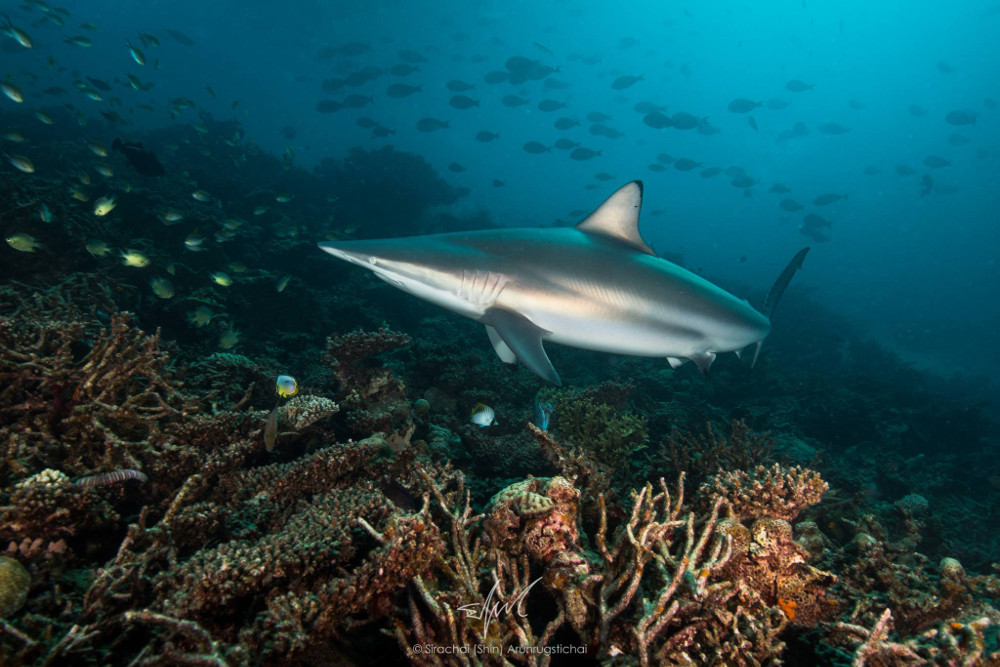
“I’m so DIZZY my head is spinning, like a WHIRLPOOL it never ends”: that is the theme song of the spinner shark.
The spinner shark looks like your average shark, but it actually has a secret talent. Makos and Great whites are known to breach (jump out of the water). The spinner shark not only breaches but it spins as it does so. The spinner shark, scientifically named Carcharhinus brevipinna, has black tips on its anal, pelvic, and dorsal fins and tail and often gets confused for the blacktip shark—but can a blacktip shark do THAT?

(there is a way to tell spinners and blacktips apart without having to see them breach, trust me).
Challenge: watch a slow-motion video or gif of a spinner shark doing its thing and see if you can count the turns.

Spinners eat your usual variety of open-ocean fish and cephalopods, but prefer to hunt just offshore. The spinning is part of their hunting technique: they will swim into a school of fish and spin while snapping its jaws…and I guess just hope that it bites something.
Spinner sharks are the reason I wish there was a shark Olympics. You can find spinner sharks spinning in tropical and sub-tropical oceans in the Atlantic, Indian, and western Pacific.
The real Sharknado, am I right?
I hope I’ve made your Shark Week a little more interesting and uplifting with these cool sharks.

Want More?
Article: Shark and Ray Superpowers
Photo: ‘Lemon shark pups in mangrove nursery’ wins prestigious award
Article: Jean-Sebastian Finger’s Report on Lemon Shark Behavioral Research for Save Our Seas Magazine
Article: Sharks-the real Fantastic Beasts
Video: Researching Great Whites with Greg Skomal
Video: Stay Home With Shedd–Sharks (Shedd Aquarium) (It’s a program aimed toward kids, but it is very informative)
Photos: Sharks find Sanctuary in Venezuela
Article: You’ll Never Guess Where this new Shark Hotspot is located

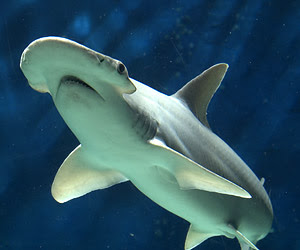
Leave a comment